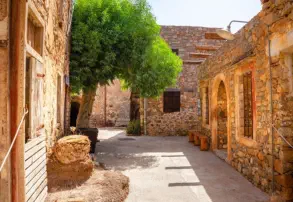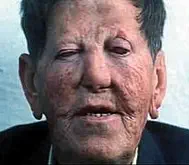The Spinalonga Story
Spinalonga is an island in the Lasithi Prefecture in Eastern Crete in the Gulf of Elounda, off the coast of a small village, Plaka. In
1903 it became a leper colony. The Bishop of Patras renovated and consecrated the Church of St. Panteleimon on the island.
However, he had a problem; where would he find a priest for the church? In Neapoli, of course; Papa Manolis Psarakis, a
parish priest in Neapoli volunteered to go to Spinalonga and remained there for 21 years. At this time little was known
about the disease and when it was proved to be contagious, patients were sent into isolation; in Greece they were sent to the
island of Spinalonga; once there they entered through “Dante’s Gate“, unaware of what was to come. During its first years there
were many horror stories; there was no infrastructure on the island and not even running water. Misdiagnosis by ignorant doctors
meant that sometimes a patient with a minor condition like psoriasis was sent to the island.
In 1936 Epaminondas Remoundakis was a 21 year old student at Athens Law School. He had contracted the disease and could no
longer keep it hidden. He was therefore despatched to Spinalonga. He established The Brotherhood of the Sick of Spinalonga and
dedicated his life to improving the conditions of the island. The houses were painted, a public cleaning service was established,
and a cinema and theatre were built. A power generator meant that the streets could be lit at night. One patient donated a
loudspeaker, which broadcast classical music in the streets. Very slowly the patients began to live as normal a life as possible; they
married and had children (who grew into adulthood without being infected). There were schools, a coffee shop and a barber.
In 1948 a drug was discovered to combat the disease and the number of patients on the island began to decrease. In 1957
Spinalonga was closed. The last person to leave the island was its priest, Chrysanthos Katsoulogiannakis, from Toplou Monastery
also in the Lasithi Prefecture near Sitia. He was not infected but had volunteered to go there and dedicate his life to the
inhabitants. He remained on the island until 1962; he had stayed to maintain the Greek Orthodox tradition of commemorating a
buried person 40 days, 6 months, 1 year, 3 years and 5 years after their death.
Today, the uninhabited island of Spinalonga, nicknamed “the grave of the living” is the second most visited site on Crete, after
Knossos. At the entrance, an inscription advises you to leave hope behind and a small plaque at the entrance to the cemetery asks
for respect for the souls that never managed to escape Spinalonga.
Epaminondas Remoundakis was born in Agia Triada, Sitia, in the Lasithi prefecture. He had four brothers and a sister. From
an early age he wanted to follow in the footsteps of his older brother, Emmanuel, and become a lawyer. In 1921 he was dealt
a crushing blow when his mother died and again, five years later, when he was diagnosed with leprosy. His sister Maria and
brother George, a doctor, also suffered from the disease and Epaminondas was sent to Athens to join them. At the Pasteur
Institute he and Maria underwent a new treatment, which was seeing some success and luckily the small mark on his arm
disappeared. After leaving school he attended the University of Athens to study law, dodging the police who were hunting
lepers. In 1930 tragedy hit again when his brother, George, passed away. And then in his third year at university the police
finally caught up with him and he was sent to Agia Barbara, the leper home.
His sister had been taken to Spinalonga, so he volunteered to go there and arrived in 1936. He established The Brotherhood
of the Sick of Spinalonga and dedicated his life to improving the conditions of the island. The houses were painted, a public
cleaning service was established, and a cinema and theatre were built. A power generator meant that the streets could be lit
at night. One patient donated a loudspeaker, which broadcast classical music in the streets. Very slowly the patients began to
live as normal a life as possible; they married and had children (who grew into adulthood without being infected). There were
schools, a coffee shop and a barber.
In 1948 a drug was discovered to combat the disease and the number of patients on the island began to decrease. Many were
cured and returned to their homes. In 1957 Spinalonga was closed and the last 20 patients were transferred to a leprosy
hospital in Athens. Epaminondas and his wife Anastasia were transferred to the leper home in Agia Barbara. He felt the need
to let the public know of the courage of the people of Spinalonga and told several trainee doctors his memoirs (unfortunately
in 1947 he had become blind due to the disease). His autobiography is called ‘Eagle without Wings’. The last person to leave
the island was its priest, Chrysanthos Katsoulogiannakis, from Touplou Monastery also in the Lasithi Prefecture near Sitia. He
was not infected but had volunteered to go there and dedicate his life to the inhabitants. He remained on the island until
1962; he had stayed to maintain the Greek Orthodox tradition of commemorating a buried person 40 days, 6 months, 1 year,
3 years and 5 years after their death. Epaminondas died in 1978 in Agia Barbara, Attica.
Today, the uninhabited island of Spinalonga, nicknamed “the grave of the living” is the second most visited site on Crete, after
Knossos. At the entrance, an inscription advises you to leave hope behind and a small plaque at the entrance to the cemetery
asks for respect for the souls that never managed to escape Spinalonga.
In 2019 Greece’s Minister of Culture submitted a nomination to UNESCO asking for Spinalonga to be declared a World Heritage
Site.

“Walking down Spinalonga
Street, stop and hold your
breath.
From some small house around
you, you will hear the echo of a
mother’s, a sister’s obituary or a
man’s sigh.
Let two tears fall from your eyes
and you will see the glitter of
millions of tears that watered
this road….” (Remoundakis)
Epaminondas Remoundakis



Here is a link to the newly developed
interactive site detailing the Island
and it’s rich history…..
.webp)
The Spinalonga Story
Spinalonga is an island in the Lasithi Prefecture in Eastern Crete in
the Gulf of Elounda, off the coast of a small village, Plaka. In 1903
it became a leper colony. The Bishop of Patras renovated and
consecrated the Church of St. Panteleimon on the island.
However, he had a problem; where would he find a priest for the
church? In Neapoli, of course; Papa Manolis Psarakis, a parish
priest in Neapoli volunteered to go to Spinalonga and remained
there for 21 years. At this time little was known about the disease
and when it was proved to be contagious, patients were sent into
isolation; in Greece they were sent to the island of Spinalonga;
once there they entered through “Dante’s Gate“, unaware of what
was to come. During its first years there were many horror stories;
there was no infrastructure on the island and not even running
water. Misdiagnosis by ignorant doctors meant that sometimes a
patient with a minor condition like psoriasis was sent to the island.
In 1936 Epaminondas Remountakis was a 21 year old student at
Athens Law School. He had contracted the disease and could no
longer keep it hidden. He was therefore despatched to
Spinalonga. He established The Brotherhood of the Sick of
Spinalonga and dedicated his life to improving the conditions of
the island. The houses were painted, a public cleaning service was
established, and a cinema and theatre were built. A power
generaor meant that the streets could be lit at night. One patient
donated a loudspeaker, which broadcast classical music in the
streets. Very slowly the patients began to live as normal a life as
possible; they married and had children (who grew into adulthood
without being infected). There were schools, a coffee shop and a
barber.
In 1948 a drug was discovered to combat the disease and the
number of patients on the island began to decrease. In 1957
Spinalonga was closed. The last person to leave the island was its
priest, Chrysanthos Katsoulogiannakis, from Toplou Monastery
also in the Lasithi Prefecture near Sitia. He was not infected but
had volunteered to go there and dedicate his life to the
inhabitants. He remained on the island until 1962; he had stayed
to maintain the Greek Orthodox tradition of commemorating a
buried person 40 days, 6 months, 1 year, 3 years and 5 years after
their death.
Today, the uninhabited island of Spinalonga, nicknamed “the grave
of the living” is the second most visited site on Crete, after
Knossos. At the entrance, an inscription advises you to leave hope
behind and a small plaque at the entrance to the cemetery asks
for respect for the souls that never managed to escape
Spinalonga.
Epaminondas Remoundakis
Epaminondas Remoundakis was born in Agia Triada, Sitia, in the
Lasithi prefecture. He had four brothers and a sister. From an
early age he wanted to follow in the footsteps of his older brother,
Emmanuel, and become a lawyer. In 1921 he was dealt a
crushing blow when his mother died and again, five years later,
when he was diagnosed with leprosy. His sister Maria and
brother George, a doctor, also suffered from the disease and
Epaminondas was sent to Athens to join them. At the Pasteur
Institute he and Maria underwent a new treatment, which was
seeing some success and luckily the small mark on his arm
disappeared. After leaving school he attended the University of
Athens to study law, dodging the police who were hunting lepers.
In 1930 tragedy hit again when his brother, George, passed away.
And then in his third year at university the police finally caught up
with him and he was sent to Agia Barbara, the leper home.
His sister had been taken to Spinalonga, so he volunteered to go
there and arrived in 1936. He established The Brotherhood of the
Sick of Spinalonga and dedicated his life to improving the
conditions of the island. The houses were painted, a public
cleaning service was established, and a cinema and theatre were
built. A power generator meant that the streets could be lit at
night. One patient donated a loudspeaker, which broadcast
classical music in the streets. Very slowly the patients began to
live as normal a life as possible; they married and had children
(who grew into adulthood without being infected). There were
schools, a coffee shop and a barber.
In 1948 a drug was discovered to combat the disease and the
number of patients on the island began to decrease. Many were
cured and returned to their homes. In 1957 Spinalonga was
closed and the last 20 patients were transferred to a leprosy
hospital in Athens. Epaminondas and his wife Anastasia were
transferred to the leper home in Agia Barbara. He felt the need to
let the public know of the courage of the people of Spinalonga
and told several trainee doctors his memoirs (unfortunately in
1947 he had become blind due to the disease). His autobiography
is called ‘Eagle without Wings’. The last person to leave the island
was its priest, Chrysanthos Katsoulogiannakis, from Touplou
Monastery also in the Lasithi Prefecture near Sitia. He was not
infected but had volunteered to go there and dedicate his life to
the inhabitants. He remained on the island until 1962; he had
stayed to maintain the Greek Orthodox tradition of
commemorating a buried person 40 days, 6 months, 1 year, 3
years and 5 years after their death. Epaminondas died in 1978 in
Agia Barbara, Attica.
Today, the uninhabited island of Spinalonga, nicknamed “the
grave of the living” is the second most visited site on Crete, after
Knossos. At the entrance, an inscription advises you to leave
hope behind and a small plaque at the entrance to the cemetery
asks for respect for the souls that never managed to escape
Spinalonga.
In 2019 Greece’s Minister of Culture submitted a nomination to
UNESCO asking for Spinalonga to be declared a World Heritage
Site.
“Walking down Spinalonga Street, stop and hold your
breath.
From some small house around you, you will hear the echo
of a mother’s, a sister’s obituary or a man’s sigh.
Let two tears fall from your eyes and you will see the glitter
of millions of tears that watered this road….”
(Remoundakis)





